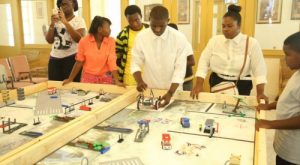(ThyBlackMan.com) There is an interesting dynamic that has grown over several years related to academic assessments.
School districts across the nation have adopted a growing policy for testing (assessments). There are local district assessments, state assessments and national assessments. There are still questions what does all the testing mean and who is using the data?
There seems to be an overwhelming focus on assessing or testing students from Pre-K to High School. The reality is that students once they enter into formative education will be tested in some form or fashion throughout their academic years. Testing to see if they  understand, comprehend, grasp, accept, conceptualize and other verbs that relate to the “light bulb” effect of knowledge illumination and grasping of important concepts to advance to the next grade.
understand, comprehend, grasp, accept, conceptualize and other verbs that relate to the “light bulb” effect of knowledge illumination and grasping of important concepts to advance to the next grade.
Assessments are just one part of the equation, students must be able to apply what they are learning to real world application. These applications are sometimes not evident in the classrooms of this nation so parents, being the first teachers must allow their children to experience opportunities to apply their learning.
Parents find the events or activities that kids can join to apply those skills they will learn in the classroom. Whether it is Boy Scouts or Girl Scout, Boys and Girls Clubs of America, Girls Inc., the national or local groups based in cities like Jacksonville, Florida; Journey Into Womanhood a successful mentoring and training program. These are opportunities for parents to get their children engaged in learning the people skills they need to apply to future career building.
The involvement shows that skills related to STEM, and STEAM are not limited to just science and those areas that kids expect, but the social skills that allow students to communicate and share information.
STEM – Science Technology Engineering Mathematics are knowledge areas that help prepare students for careers, building to the opportunity to start a career. Students must know the language and be able to speak it when striving for a career. Science and Technology changes just about every 6 to 9 months so students must adapt their vocabulary to match the vernacular of their area of interest. Engineering terminology is consistent with the process of solving problems that many kids enjoy doing.
Engineers solve problems; Mathematics can be learned from K to graduating high school, but still must be applied so no one cheats you out of your money when you buy candy at the store or even a fast food restaurant. When purchasing a home, vehicle or even understanding budgeting for life, mathematics is important, schools must teach it to apply to real life.
Education allows for the accumulation of information, facts, access to data, students still need to learn how to apply these to real life experiences. Parents must understand that value of “exposure,” the purpose of application and implementation is valuable. So in the 21st century, STEAMing your kids is necessary. “The careers now and in the future require a foundation of education and transference of information from memory to momentum of execution.” Wm Jackson, Edward Waters College
Engagement in STEM and STEAM, are ways to grasp the concepts necessary to build knowledge to be successful in a dynamically changing world. Parents take your children to museums, library events, cultural activities, family field trips to where you are doing stuff to be engaged.
What is the issue with having children learn about what the world has to offer and provide in a productive and positive way?
Parents allow your children to build, design, create, be innovative and explorers. Their future depends on what type of foundation they have now. Students learn by doing not by listening, so engagement is vitally important and necessary. Student lead instruction, guided learning, project based learning and the list goes on when children need to be engaged and active. Hands-on learning that is student centered is not a trend, it is a reality and much needed.
Too many teachers are still teaching in the past mode of factory workers style and lecture instructional model. Students are not factory workers, they are not all the same so instruction should be diverse in its approach to meet the educational needs of the diversity of the classroom. The explosion of video games, interactive toys, digital platforms and tools is needed to guide learning that challenges students to be creative and innovative.
Teachers need to incorporate collaborative learning with content rich resources.
Adapting to a STEM / STEAM project based instruction addresses the issues to engagement and active learning. A game of questions for STEM? Encourage students to ask each other in an intelligent way questions to encourage discussion:
What did you see happen? – What did you try and why? What things did you notice when it happened? What is another way to do it? – What has changed now? What were your expectations and were they met? – What did you learn? – Where can you apply what you learned? – Can you teach others?
Teachers must be members of Professional Learning Communities (PLC’s) to share and gain resources from other professional educators. Children are naturally curious, so why not enhance, support and encourage a natural ability to question. Just guide the questioning to everyday life and teach children to be “smart creatives,” and “thought leaders.”
Allow students to be innovators and explorers, show students especially students of color and culture they are capable. STEM and STEAM are the new ways to accomplish this and should be used to lead future generations to learn how to solve problems before we realize they are problems.
The need for STEM workers can be seen as technology is integrated increasingly in society. Drones, driverless cars, medical research, global warming, increased space exploration and even inner space in our oceans requires knowledge workers that are visionaries, smart creatives and innovators.
STEM – STEAM – STREAM – CSTEAM – STEM2
Staff Writer; William D. Jackson
Find out more about this talented writer over at; OCS For Education.

















Leave a Reply